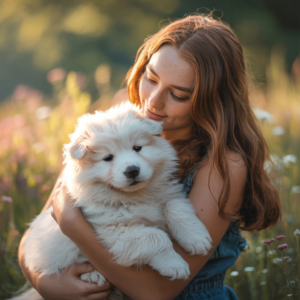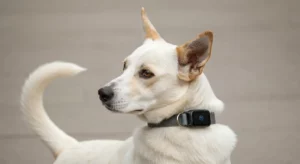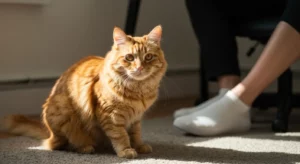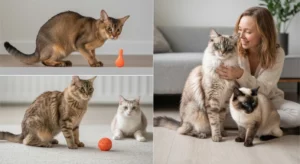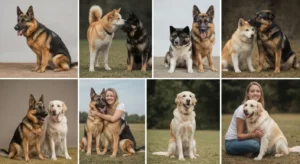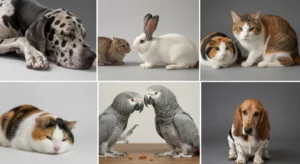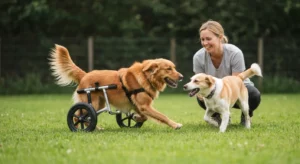For as long as I can remember, my life has been a delightful, fur-covered chaos of wagging tails and purring engines. I’ve spent over a decade volunteering at our local animal shelter, fostering countless critters, and learning that the line between “cat person” and “dog person” is blurrier than most people think. I’ve seen it all—the aloof cats, the bouncing dogs, and everything in between.
But the animals that have always fascinated me the most are the cats who seem to have missed the memo on feline aloofness. These are the cats who greet you at the door, demand a game of fetch, follow you from room to room, and seem to crave the kind of companionship we usually associate with our canine friends.
If you’re a dog lover who’s “cat-curious,” or a cat person who wants a more interactive and social feline, you’ve come to the right place. Through my years of fostering and late-night shelter shifts, I’ve met some incredible felines who completely redefine what it means to be a cat. Here are 12 of the most wonderfully dog-like cat breeds I’ve had the pleasure of knowing.
-
The Abyssinian: My Little Shadow, Leo
I’ll never forget Leo, a stunning ruddy Abyssinian I fostered for a few months. From day one, he wasn’t interested in finding a quiet corner to nap. His mission was to be my supervisor for every single household chore. Washing dishes? He was on the counter, patting the bubbles. Folding laundry? He was diving into the warm basket, “helping” me sort. He wasn’t just present; he was an active participant in my life.
His most dog-like trait was his obsession with fetch. It started by accident when I flicked a bottle cap across the kitchen floor. He pounced on it, picked it up delicately in his mouth, trotted back, and dropped it right at my feet, staring at me expectantly. We played this game every single day. He was whip-smart, intensely curious, and needed constant stimulation. He wasn’t a lap cat in the traditional sense; he was an adventure buddy who just happened to be a cat.
My takeaway: An Abyssinian is not a pet for someone who wants an independent, hands-off cat. They thrive on interaction and mental challenges. If you want a brilliant, energetic companion to share your life with, this is your breed. Be prepared to invest in puzzle toys and lots of playtime!
-
The Ragdoll: A Gentle, Floppy Giant Named Duke
My next-door neighbor has a Ragdoll named Duke, and he’s less of a cat and more of a 20-pound, purring, fluffy cloud of love. Every time I visit, Duke is the official greeter. He doesn’t just meow; he ambles to the door and literally flops over at my feet for a belly rub. The name “Ragdoll” is no joke—the moment you pick him up, he goes completely limp and trusts you implicitly.
He follows his family around like a loyal puppy, settling in whatever room they’re in. He’s never more than a few feet away, a silent, fluffy guardian. I’ve watched him patiently endure being dressed in doll clothes by their six-year-old daughter without so much as a flick of his tail. His calm, gentle, and utterly devoted nature is more reminiscent of a Golden Retriever than any cat I’ve ever met.
My takeaway: Ragdolls are the epitome of a companion cat. They are placid, affectionate, and deeply bonded to their families. They are perfect for households with children or other pets due to their patient temperament. Just be aware their trust is absolute, so they must be indoor-only cats as they wouldn’t know how to defend themselves.
-
The Maine Coon: Moose, the Leash-Walking Wonder
Moose was a legend at the shelter. A massive, majestic Maine Coon with ear tufts that could rival a lynx’s, he had an equally huge personality. He was surrendered because his owners were moving and couldn’t take him, and my heart broke for him. But Moose didn’t mope. Instead, he immediately started making friends—with staff, volunteers, and even some of the calmer dogs.
I started working on harness training with him to give him some enrichment outside his kennel. To my shock, he took to it almost instantly. Our “walks” around the shelter’s private garden became the highlight of my day. He would trot alongside me, chirping and trilling at birds, investigating every leaf with intense focus. He wasn’t just tolerating the leash; he seemed to genuinely enjoy the shared activity. He was a gentle, intelligent giant who proved that with a little patience, a cat can absolutely be your walking partner.
My takeaway: Maine Coons are often called the “dogs of the cat world” for a reason. They are trainable, good-natured, and sociable. If you dream of taking your cat on safe, supervised outdoor adventures, a Maine Coon is one of your best bets.
-
The Siamese: My First “Chatty” Cat, Cleo
Years ago, before my shelter days, I adopted a Siamese kitten I named Cleo. I was not prepared for the sheer volume of conversation she would bring into my life. Cleo didn’t just meow; she had a whole vocabulary of yowls, chirps, and mumbles to express her every thought and desire. She’d “tell” me about her day when I got home from work, complain loudly if her dinner was five minutes late, and purr like a motorboat when she curled up on my lap.
Her bond with me was fiercely loyal. She was wary of strangers but adored me with an intensity I’d only ever seen in dogs. She needed to be involved in everything, from my morning coffee to my evening TV shows. Living with Cleo taught me that cats can be just as demanding of your attention and affection as any dog—and just as rewarding.
My takeaway: A Siamese cat is a commitment. They are incredibly social and can become lonely or destructive if left alone for too long. They are perfect for people who are home a lot and want a pet who is truly a talkative, engaging member of the family.
-
The Burmese: The Ultimate “Velcro” Foster, Coco
I once fostered a Burmese cat named Coco, and I quickly learned why they’re called “velcro cats.” Coco’s life mission was to be physically attached to me at all times. If I was on the couch, she was in my lap. If I was at my desk, she was draped over my shoulders like a living scarf. She even tried to follow me into the shower, patting at the glass door with a concerned look on her face.
Her playfulness was kitten-like, even though she was a full-grown adult. She loved chasing teaser wands and would perform incredible acrobatic leaps. The Burmese personality is a delightful mix of puppy-like playfulness and an insatiable need for cuddles. They retain that energy and love of play well into their senior years.
My takeaway: If you want a cat that will be your constant shadow and a source of endless affection, the Burmese is an excellent choice. They are people-centric to the extreme, so like the Siamese, they don’t do well with long periods of solitude.
-
The Turkish Angora: Ghost, the Mischievous Mastermind
Ghost was a stunning, all-white Turkish Angora with one blue eye and one green. He was as smart as he was beautiful, and his intelligence was often directed towards mischief. He learned how to open kitchen cabinets, turn on faucets, and even figured out how to nudge my bedroom door open when he decided it was time for me to wake up.
He was less of a cuddler and more of a playmate. His favorite game was hide-and-seek. I’d hide, call his name, and he would systematically search the house until he found me, announcing his victory with a triumphant trill. He was graceful, elegant, and possessed a problem-solving ability that I’d typically associate with a clever Border Collie. He wasn’t just a pet; he was a daily challenge to my wits.
My takeaway: Turkish Angoras are incredibly intelligent and athletic. They need a home that can keep them entertained. Puzzle feeders, interactive toys, and even teaching them tricks are great ways to keep their sharp minds engaged. They often bond very strongly with one person, becoming their loyal, clever companion.
-
The Manx: Stumpy, the Fearless Protector
The Manx is a fascinating breed, known for its natural lack of a tail. I got to know one named Stumpy who belonged to a friend. Stumpy was built like a little bulldog—stocky, powerful, and surprisingly fast. He had a distinct, rabbit-like hop when he ran. But his most dog-like quality was his protective nature.
He was the undisputed king of his household. He was gentle and loving with his family, but when the mail carrier approached the door, Stumpy would emit a low, guttural growl that was surprisingly intimidating. He was fiercely loyal and acted as a tiny, furry watchdog. He was also an incredible mouser, proudly presenting his “gifts” with the same pride a terrier would show.
My takeaway: Manx cats are robust, playful, and can be very protective of their families. They are great communicators and form powerful bonds. Their history as working cats on farms makes them intelligent and somewhat territorial, in the most endearing way.
-
The Sphynx: My Little Warm Alien, Gollum
Fostering a Sphynx was a completely new experience. I affectionately called him Gollum because of his big eyes and wrinkly skin, and he was my “precious” indeed. With no fur to keep him warm, his drive for affection was also a drive for survival. He craved body heat, making him the most persistent cuddler I’ve ever met. He would burrow under blankets, tuck himself inside my sweater, and sleep pressed against my neck every night.
Beyond his need for warmth, he was a total clown. He loved being the center of attention, performing goofy antics to get a laugh, and would greet any and all visitors with overwhelming curiosity and a demand for pats. He was energetic, loving, and had a personality that was 100 times bigger than his hairless little body.
My takeaway: A Sphynx requires a lot of care—regular bathing to manage skin oils, and protection from sun and cold. But what you get in return is a social, hilarious, and endlessly affectionate companion who will make you the center of their universe.
-
The American Bobtail: Bandit and His Fetching Obsession
The American Bobtail looks a bit like a wild bobcat with its short tail and muscular build, but their personality is pure golden retriever. I met a Bobtail named Bandit at an adoption event, and his charm was irresistible. His owner explained that Bandit’s favorite thing in the world was playing fetch.
Skeptical, I watched as she crumpled up a piece of paper and tossed it. Bandit took off like a shot, snagged it, and trotted right back, dropping it at her feet to go again. He did this for a solid ten minutes, his little stub of a tail wiggling with excitement the entire time. He was confident, friendly with strangers, and had the playful, easy-going nature of a family dog.
My takeaway: American Bobtails are fantastic for active families. They are known for being intelligent, devoted, and they genuinely love interactive games like fetch. They also adapt well to different environments and are known to get along well with dogs.
-
The Siberian: Sasha, the Clever Escape Artist
Siberians are magnificent cats, known for their dense, triple-layered coats and impressive size. I fostered a female named Sasha, and I was immediately struck by her powerful intelligence. She was a problem-solver. I once watched her study the kitchen faucet, and after a few attempts, she figured out how to nudge the lever just enough to get a stream of water. I had to install child-proof locks!
She was also incredibly devoted. She would wait by the door for me to come home and follow me around the house, “talking” to me in a series of sweet chirps and trills. Despite her wild look, she was a gentle and affectionate soul who simply wanted to be involved in her person’s life. Many people with cat allergies also find they can tolerate Siberians, which is a wonderful bonus.
My takeaway: Siberians are a great mix of playful energy and deep affection. Their intelligence requires stimulation, so puzzle toys and interactive play are a must. They offer a dog-like loyalty in a stunning, fluffy package.
-
The Ocicat: Zola, the Social Butterfly
The Ocicat is a breed that was developed to look like a wild ocelot, but don’t let their spots fool you. Their temperament is purely domestic and incredibly social. I cared for an Ocicat named Zola while her family was on vacation, and I was amazed by how much she hated being alone. She acted less like a solitary feline and more like a member of a pack.
Zola needed constant companionship. She greeted me with enthusiasm, was happy to meet new people, and adapted seamlessly when my friend brought her friendly Labrador over for a visit. She was confident, outgoing, and treated everyone like a long-lost friend. She didn’t just tolerate social situations; she thrived in them.
My takeaway: Ocicats are not for people who want a quiet, independent cat. They are social animals that need a lot of interaction, whether from humans or other pets. If you have a busy, active household, an Ocicat will fit right in.
-
The Birman: The Patient and Playful Pierre
My final entry is the lovely Birman. I met a handsome Birman named Pierre during a home visit for the shelter. He was the perfect family cat. He possessed the pointed coloring of a Siamese and the long fur of a Persian, but his personality was uniquely his own—a perfect balance of playful and calm.
He wasn’t as hyperactive as an Abyssinian or as demanding as a Siamese, but he was always present and engaged. He would gently bat at a toy if invited to play and then curl up contentedly on the nearest lap when playtime was over. He was incredibly patient with the family’s toddler, absorbing clumsy pats with a gentle purr. He was a dog-like companion in his quiet, constant, and loving presence.
My takeaway: Birmans are gentle souls that offer a more low-key version of dog-like companionship. They are social and affectionate without being overwhelming, making them an ideal choice for families or anyone seeking a calm, loving presence in their home.
My journey with these incredible animals has taught me that personality is so much more than a species label. If you love the loyalty, playfulness, and companionship of a dog but find yourself drawn to the grace and mystique of a cat, I promise you don’t have to choose. There’s a whole world of dog-like cat breeds out there, just waiting to fetch a toy, follow you around, and change everything you thought you knew about felines.


